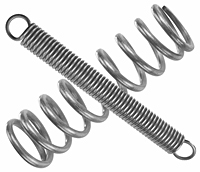
Springs are available in different types. By definition, a spring is an elastic device that’s capable of storing mechanical energy. When exposed to a force, it will deform while simultaneously storing mechanical energy. There are wire springs, however, and there are flat springs. They both consist of energy-storing elastic devices, but they feature different designs.
What Are Wire Springs?
Also known as mechanical wire springs, wire springs are characterized by a coil-like design. They are made of pieces of metal wire. The metal wire is wound up in the shape of a coil.
Wire springs can further be broken down into extension or compression springs. Extension springs are wire springs that become longer when exposed to a force, whereas compression springs are wire springs that become shorter when exposed to a force. They both feature a coiled-like design, and they are both made of metal wire. Therefore, extension and compression springs are classified as wire springs.
What Are Flat Springs?
Flat springs are characterized by a flat design. They are made of flat metal stock. Most flat springs are stamped from flat metal stock. With that said, some of them are machined and wound, instead. Regardless, all flat springs feature a flat design consisting of metal stock.
Like with wire springs, flat springs are available in different types. Some of them consist of a flat ring with a slight overlap. The overlap allows them to flex while storing mechanical energy. Other flat springs consist of a curved or conical piece of flat metal stock.
Differences Between Wire and Flat Springs
Wire springs and flat springs aren’t the same. Wire springs are made of metal wire and feature a coil-like design. Flat springs are made of flat metal stock and feature a flat design.
When compared to flat springs, wire springs offer increased travel. They can extend or compress longer distances. Flat springs, though, typically support heavier loads. They won’t break or otherwise sustain damage. Even when used with heavy loads, flat springs will continue to store mechanical energy.
Flat springs are often used in conjunction with fasteners. They can prevent fasteners from loosening, in fact. Normally, vibrations can cause fasteners to loosen. Exposure to vibrations may force a bolt or screw out of the hole in which it was installed. But a flat spring can secure the bolt or screw in place. You can use the flat spring like a washer around the screw or bolt.
